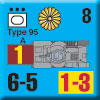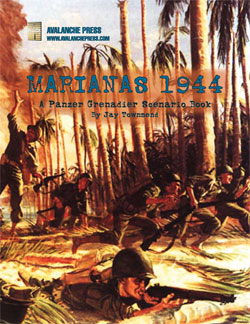| Saipan 1944:
Publisher’s Preview
By Mike Bennighof, Ph.D.
June 2020
Jay Townsend wanted Panzer Grenadier to return to the Pacific Theater with a full-sized boxed game. So he did what any reasonable gamer would do: he designed it himself and sent it to us. And we found it good, and we published it. And we’re very glad that we did.
 Saipan 1944 carries the Fourth Edition rules for Panzer Grenadier, an improved and streamlined new version of the popular game system. There are full-color play aids, and a brand-new sheet of colorful markers. Very colorful markers. But it’s not a radical departure: if you know how to play Panzer Grenadier, you know how to play this game already. You can pop open the box and commence to playing right away. Saipan 1944 carries the Fourth Edition rules for Panzer Grenadier, an improved and streamlined new version of the popular game system. There are full-color play aids, and a brand-new sheet of colorful markers. Very colorful markers. But it’s not a radical departure: if you know how to play Panzer Grenadier, you know how to play this game already. You can pop open the box and commence to playing right away.
Inside, you’ll find some very nice toys. Saipan 1944 is one of the best-looking games we’ve made, starting with the four Saipan maps. Like the island itself, they’re a mix of jungles (thick and thin), cane fields, swamps and beaches. You can get a nice close look at them here.
 The playing pieces are die-cut and silky-smooth on both sides, without the massive damage usually inflicted by 30,000 pounds of force as with many die-cut pieces. They’re the pieces we’ve been using for a couple of years now, fully interchangeable with other games that carry the old-style die-cut pieces like The Kokoda Campaign. The playing pieces are die-cut and silky-smooth on both sides, without the massive damage usually inflicted by 30,000 pounds of force as with many die-cut pieces. They’re the pieces we’ve been using for a couple of years now, fully interchangeable with other games that carry the old-style die-cut pieces like The Kokoda Campaign.
These pieces really are too wonderful to describe. We’ve used them many times now and are very pleased with them. As of right now, these are about as good as it gets.
 And what’s on the pieces? Four separate forces battle for Saipan: the Japanese Army, the Japanese Navy’s Special Naval Landing Force, the U.S. Army and the United States Marine Corps. All of them are well-armed; the Japanese even have a respectable armored force on the island. But the Marines bring the awesome to the battlefield: the 1944-model Marine Rifle platoon is designed to put out maximum firepower, and it does. Most other nations’ heavy weapons platoons can’t match Marine firepower. Which is as it should be. The Marine heavy weapons platoon has the firepower of two Japanese machine gun platoons. And what’s on the pieces? Four separate forces battle for Saipan: the Japanese Army, the Japanese Navy’s Special Naval Landing Force, the U.S. Army and the United States Marine Corps. All of them are well-armed; the Japanese even have a respectable armored force on the island. But the Marines bring the awesome to the battlefield: the 1944-model Marine Rifle platoon is designed to put out maximum firepower, and it does. Most other nations’ heavy weapons platoons can’t match Marine firepower. Which is as it should be. The Marine heavy weapons platoon has the firepower of two Japanese machine gun platoons.
The Marines have powered up in other ways since Guadalcanal. They now have first-line armor in their tank battalions; the Germans might have better tanks than the M4 Sherman, but the Japanese do not. Their Shinhoto Chi-Ha is no match for the Sherman, even if it weren’t driven by Marines. Marine artillery is of the best quality, as well as their support weapons, and they have special flamethrower platoons, too. And rocket trucks. It just doesn't seem fair.
 The “Japanese Marines,” the SNLF, have the same firepower they boasted at the start of the Pacific War. That was only slightly less than that of the U.S. Marines, but now they’re terribly outgunned. To make up for that, they are well-entrenched with fortified caves to aid their defense, and have fanatically high morale. They’re going to need both. The “Japanese Marines,” the SNLF, have the same firepower they boasted at the start of the Pacific War. That was only slightly less than that of the U.S. Marines, but now they’re terribly outgunned. To make up for that, they are well-entrenched with fortified caves to aid their defense, and have fanatically high morale. They’re going to need both.
The U.S. Army has not matched the Marines’ wholesale issuance of automatic weapons, but they are no slouches in the firepower department, either. The standard U.S. Army infantry platoon remains the same in Panzer Grenadier terms throughout the war. On Saipan, they have some armor support, good artillery, and (in the later scenarios, once airfields for them have been secured) waves of the awesome P47 fighter-bomber.
 The Japanese Army is very brave, which is important for them, because they have no better firepower than the SNLF. They do have tanks, but these are tanks that were barely adequate when Japan invaded China in 1937. Seven years later, they might as well be museum pieces. The Japanese player will have to use them carefully. The Japanese Army is very brave, which is important for them, because they have no better firepower than the SNLF. They do have tanks, but these are tanks that were barely adequate when Japan invaded China in 1937. Seven years later, they might as well be museum pieces. The Japanese player will have to use them carefully.
Saipan 1944 has 40 scenarios, which seems like a lot for such a small island, but there was a lot of fighting before the Americans could call it conquered – the last organized resistance on Saipan ended in December 1945, three months after Japan’s surrender. Those scenarios cover many different kinds of fighting, starting with massed amphibious landings. Panzer Grenadier has covered landings before, in Guadalcanal and a handful of other scenarios in other games and books, but nothing like this. Waves of Marines come ashore riding armored amphibious carriers, with many of the carriers sporting turrets to offer direct fire support. The Japanese meet them with heavy artillery fire and well-entrenched troops.
 As the Americans advance inland, they find the Japanese stubbornly dug into hills and caves, refusing to meekly give up the island. There are jungle battles, a small diversion into urban warfare, and tank battles, too. Plus a huge banzai charge. And that's not all: you can move the fighting to Guam and Tinian with the expansion book, Marianas 1944. As the Americans advance inland, they find the Japanese stubbornly dug into hills and caves, refusing to meekly give up the island. There are jungle battles, a small diversion into urban warfare, and tank battles, too. Plus a huge banzai charge. And that's not all: you can move the fighting to Guam and Tinian with the expansion book, Marianas 1944.
When Jay set out to design this game, I didn’t really think it could be done. We’d looked at a Saipan proposal years ago from some other designer, a game that covered the whole island. I think it took two dozen Panzer Grenadier sized maps. So Saipan was too large for a “historical” map approach, and I figured that made it also too small for the generic map approach. But the maps to allow all of the scenarios to be fought out on just four of them, without sacrificing variations in terrain. I’m always impressed to see someone achieve what I believed could not be done.
 The result of all that is a very fine package: physically beautiful, with a wide range of challenging scenarios. Saipan 1944 is a Pacific island battle, which means there aren’t going to be the sweeping tank maneuvers of Broken Axis or Burning Tigers. And the Japanese can only stand up to American firepower by making full use of what advantages they have. The fighting is going to take place at short range, and it is going to be bloody and brutal. If that sort of intensity appeals to you, then this is your game. The result of all that is a very fine package: physically beautiful, with a wide range of challenging scenarios. Saipan 1944 is a Pacific island battle, which means there aren’t going to be the sweeping tank maneuvers of Broken Axis or Burning Tigers. And the Japanese can only stand up to American firepower by making full use of what advantages they have. The fighting is going to take place at short range, and it is going to be bloody and brutal. If that sort of intensity appeals to you, then this is your game.
Saipan 1944 is here! Click here to order!
Sign up for our newsletter right here. Your info will never be sold or transferred; we'll just use it to update you on new games and new offers.
Mike Bennighof is president of Avalanche Press and holds a doctorate in history from Emory University. A Fulbright Scholar and NASA Journalist in Space finalist, he has published over 100 books, games and articles on historical subjects.
He lives in Birmingham, Alabama with his wife, three children and his dog, Leopold.
|
